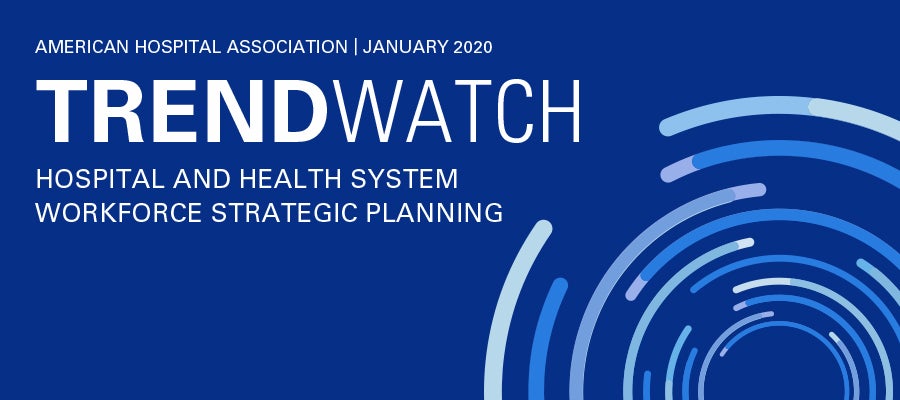

TRENDWATCH: Executive Summary: Hospital and Health System Workforce Strategic Planning
America’s hospitals and health systems are at the center of their communities, both as providers of critical services and as large – and often the largest – employers. Labor is the largest single cost for most hospitals, and the workforce is essential to the critical mission of providing life-saving care. Although there are challenges, there also are opportunities to improve care, motivate and re-skill staff, and modernize processes and business models that reflect the shift toward providing the right care, at the right time, in the right setting.
A National Snapshot of the Hospital Workforce
In 2018, America’s hospitals and health systems treated 143 million people in emergency departments, provided 623 million outpatient visits, performed over 28 million surgeries and delivered nearly 4 million babies. Every year, hospitals provide vital health care services to hundreds of millions of people. However, the importance of hospitals to their communities extends far beyond the health care services they provide.
Hospitals are significant national employers – more than 6 million individuals work for hospitals in full- or parttime positions. Hospitals also purchase $1,010 billion in goods and services from other businesses per year, creating economic value for the community. In fact, with these ripple effects included, each hospital job supports almost two additional jobs, and every dollar spent by a hospital supports roughly $2.30 of additional business activity in the economy. Overall, hospitals support 17.3 million jobs, or one out of nine jobs, and $3.3 trillion in economic activity. (Figures 1 and 2)
Challenges and Opportunities Facing the Hospital Workforce
There are a number of challenges facing hospitals as they build and nurture a talented and dedicated
workforce, and hospitals and health systems are rising to meet these challenges.
Professional shortages can strain a hospital’s care delivery and finances, aggravate other workforce challenges such as burnout, and require costly mitigations. Shortages present themselves across all types of professions (including clinical and nonclinical), hospital types and geography. Hospitals are addressing this obstacle by offering incentive programs, engaging in non-traditional activities aimed at reinforcing the hospital’s mission and culture, and employing new technologies, such as telehealth and artificial intelligence.
Financial pressures are fueled by the high rate of projected growth in employment of several health care professions, which may spur more competition for qualified professionals and increase salaries, especially as professionals have more student debt. Hospitals and health systems are innovating care approaches and advocating to improve hospital reimbursement rates and reducing uninsured and underinsured.
Burnout among professionals can cause diminished functioning, attention and memory, resulting in negative organizational consequences. However, hospitals are reducing administrative burden through upgraded technology and by offering programs that improve work-life balance and commitment to the organization’s mission.
Workplace violence occurs at a higher rate in health care than in the general workforce. To prevent violence in the hospital setting, hospitals and health systems have installed cameras and security-call buttons; limited work-area access to people with badges; limited guest hours; installed metal detectors; increased police presence; implemented de-escalation training and emergency preparedness; and taken a variety of other steps. In 2018, 57% of hospitals offered workplace violence prevention programs. According to a 2017 AHA report, hospitals spent an estimated $1.1 billion in security and training costs to prevent violence within their facilities, plus $429 million in medical care, staffing, indemnity and other costs resulting from violence against hospital workers.
Hospitals have sought to ensure that care is delivered at the right time in the right setting, and the hospital workforce is evolving to address this shift. For a variety of reasons, health care is increasingly delivered outside of traditional settings and is evolving to teambased models of care. Care continues to shift away from inpatient settings, with a decrease in inpatient admissions of 1.7 million between 2009 and 2018. Hospitals and health systems are deploying a number of new care models and technologies to supplement the workforce in supporting this shift, including: teambased models that combine physicians with Advanced Practice Providers and nurses; telehealth; artificial intelligence; and other emerging technologies, such as connected and cognitive devices, electroceuticals, targeted and personalized medicine, robotics, 3D printing, big data and analytics, blockchain and automation.
Hospitals must develop a diverse and inclusive workforce to reflect the diversity of the community. This is imperative to ensure culturally competent, equitable access to care for everyone. Disparities elimination strategies within the health care setting are increasing the cultural competency of hospital services. Hospitals also are recruiting and training talent from within their communities.
Conclusion
A robust, skilled hospital workforce is essential to delivering high-quality care. The unique role of hospitals and health systems in ensuring the health of their communities – both medically and economically – compounds the importance of addressing workforce challenges. Regardless, hospitals are embracing opportunities to reflect the changing care delivery models and the needs of their communities.

